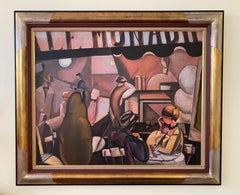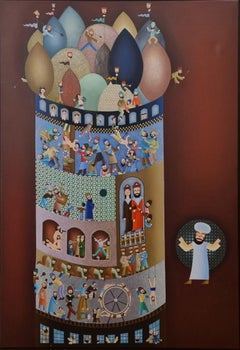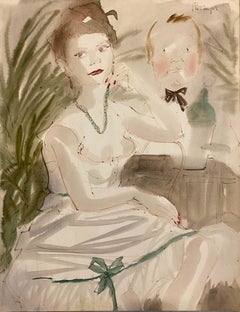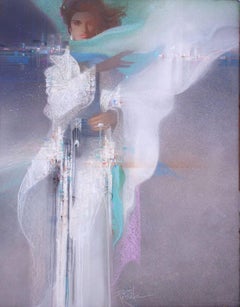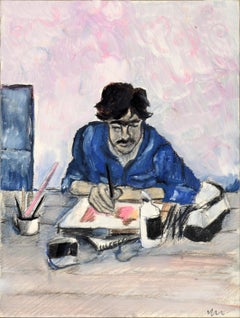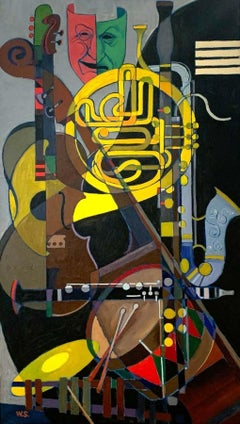Art Deco Figurative Paintings
to
2
4
4
4
1
2
1
2
Overall Height
to
Overall Width
to
220
115
83
70
57
36
31
7
7
5
1
5
5
3
2
1
1
1
1
157
44
3
32
46
13
9
5
3
14
8
1
1
1
1
1
5
3
3
3
1
Style: Art Deco
Period: 1960s
Au Cafe
By Francois Chabrier
Located in Los Angeles, CA
FRANCOIS CHABRIER
“”AU CAFE"
OIL ON CANVAS, SIGNED
FRANCE, C.1960
32.5 X 39.5 INCHES
Framed 41 x 48 inches.
François Chabrier
Born 1916
François Chabrier was born in 1916 in Bel...
Category
1960s Art Deco Figurative Paintings
Materials
Canvas, Oil
Jonah before Nineveh
By David Sharir
Located in Jerusalem, IL
The art of David Sharir draws upon many elements. He has found inspiration from such forms of art as the calligraphy of Torah scribes, medieval Hebrew manuscripts...
Category
1960s Art Deco Figurative Paintings
Materials
Canvas, Oil
Parisienne en Vacance
Located in Los Angeles, CA
Charming French oil painting c1960.
Beautiful French frame.
Category
1960s Art Deco Figurative Paintings
Materials
Canvas, Oil
Au Bar
Located in Los Angeles, CA
PHILIPPE NOYER
"AU BAR"
WATERCOLOR, SIGNED
FRANCE, C.1960S
25.5 X 19.5 INCHES
Philippe Henri Noyer
1917-1985
Philippe Henri Noyer was born on June 28, 1917 in Lyons, France. After a traditional education at the elite Ecole des Roches, Noyer enrolled in the Ecole des Beaux Arts in Lyon. Next he moved to Paris, where he worked in decorative arts and advertising. It was during this time, he discovered his talent for oil painting, officially starting his painting career in 1943.
That same year, Noyer met the famed Parisian art deal, Emmanuel David, who would promote his work and career. Noyer produced many portraits, for which he quickly gained an international reputation, but he also painted dream figures in rural or maritime settings, compositions that were classical in technique but surreal in concept. In 1947, Noyer held his first one-man show at the prestigious Drouant-David Gallery in Paris.
In 1949 the gallery consigned twenty of Noyer’s paintings to an American art dealer who had agreed to organize an exhibition of them in the United States. However the American dealer sold the paintings at cost, in order cover a gambling debt, to Robert Goldstein...
Category
1960s Art Deco Figurative Paintings
Materials
Watercolor
Art Deco Style Portrait of beautiful woman Painting
By Bob Peak
Located in Miami, FL
This beautiful work by the great American Illustrator Bob Peak has a sister work in the collection of the Lucas Museum of Narrative Art in Los Angles.
We feel that our work has a lit...
Category
1960s Art Deco Figurative Paintings
Materials
Acrylic, Fiberboard, Masonite, Mixed Media
Related Items
The Abduction of the Sabine Women , a Renaissance drawing by Biagio Pupini
Located in PARIS, FR
This vigorous drawing has long been attributed to Polidoro da Caravaggio: The Abduction of the Sabine Women is one of the scenes that Polidoro depicted between 1525 and 1527 on the façade of the Milesi Palazzo in Rome. However, the proximity to another drawing inspired by this same façade, kept at the Ecole des Beaux-Arts, and to other drawings inspired by Polidoro kept at the Musée du Louvre, leads us to propose an attribution to Biagio Pupini, a Bolognese artist whose life remains barely known, despite the abundant number of drawings attributed to him.
1. Biagio Pupini, a Bolognese artist in the light of the Roman Renaissance
The early life of Biagio Pupini, an important figure of the first half of the Cinquecento in Bologna - Vasari mentions him several times - is still poorly known. Neither his date of birth (probably around 1490-1495) nor his training are known. He is said to have been a pupil of Francesco Francia (1450 - 1517) and his name appears for the first time in 1511 in a contract with the painter Bagnacavallo (c. 1484 - 1542) for the frescoes of a church in Faenza. He then collaborated with Girolamo da Carpi, at San Michele in Bosco and at the villa of Belriguardo.
He must have gone to Rome for the first time with Bagnacavallo between 1511 and 1519. There he discovered the art of Raphael, with whom he might have worked, and that of Polidoro da Caravaggio. This first visit, and those that followed, were the occasion for an intense study of ancient and modern art, as illustrated by his abundant graphic production.
Polidoro da Caravaggio had a particular influence on the technique adopted by Pupini. Executed on coloured paper, his drawings generally combine pen, brown ink and wash with abundant highlights of white gouache, as in the drawing presented here.
2. The Abduction of the Sabine Women
Our drawing is an adaptation of a fresco painted between 1525 and 1527 by Polidoro da Caravaggio on the façade of the Milesi Palace in Rome. These painted façades were very famous from the moment they were painted and inspired many artists during their stay in Rome. These frescoes are now very deteriorated and difficult to see, as the palace is in a rather narrow street.
The episode of the abduction of the Sabine women (which appears in the centre of the photo above) is a historical theme that goes back to the origins of Rome and is recounted both by Titus Livius (Ab Urbe condita I,13), by Ovid (Fasti III, 199-228) and by Plutarch (II, Romulus 14-19). After killing his twin brother Romus, Romulus populates the city of Rome by opening it up to refugees and brigands and finds himself with an excess of men. Because of their reputation, none of the inhabitants of the neighbouring cities want to give them their daughters in marriage. The Romans then decide to invite their Sabine neighbours to a great feast during which they slaughter the Sabines and kidnap their daughters.
The engraving made by Giovanni Battista Gallestruzzi (1618 - 1677) around 1656-1658 gives us a good understanding of the Polidoro fresco, allowing us to see how Biagio Pupini reworked the scene to extract this dynamic group.
With a remarkable economy of means, Biagio Pupini takes over the left-hand side of the fresco and depicts in a very dense space two main groups, each consisting of a Roman and a Sabine, completed by a group of three soldiers in the background (which seems to differ quite significantly from Polidoro's composition).
The balance of the drawing is based on a very strongly structured composition. The drawing is organised around a median vertical axis, which runs along both the elbow of the kidnapped Sabine on the left and the foot of her captor, and the two main diagonals, reinforced by four secondary diagonals. This diamond-shaped structure creates an extremely dynamic space, in which centripetal movements (the legs of the Sabine on the right, the arm of the soldier on the back at the top right) and centrifugal movements (the arm of the kidnapper on the left and the legs of the Sabine he is carrying away, the arm of the Sabine on the right) oppose each other, giving the drawing the appearance of a whirlpool around a central point of support situated slightly to the left of the navel of the kidnapper on the right.
3. Polidoro da Caravaggio, and the decorations of Roman palaces
Polidoro da Caravaggio was a paradoxical artist who entered Raphael's (1483 - 1520) workshop at a very young age, when he oversaw the Lodges in the Vatican. Most of his Roman work, which was the peak of his career, has disappeared, as he specialised in facade painting, and yet these paintings, which are eminently visible in urban spaces, have influenced generations of artists who copied them abundantly during their visits to Rome.
Polidoro Caldara was born in Caravaggio around 1495-1500 (the birthplace of Michelangelo Merisi, known as Caravaggio, who was born there in 1571), some forty kilometres east of Milan. According to Vasari, he arrived as a mason on the Vatican's construction site and joined Raphael's workshop around 1517 (at the age of eighteen according to Vasari). This integration would have allowed Polidoro to work not only on the frescoes of the Lodges, but also on some of the frescoes of the Chambers, as well as on the flat of Cardinal Bibiena in the Vatican.
After Raphael's death in 1520, Polidoro worked first with Perin del Vaga before joining forces with Maturino of Florence (1490 - 1528), whom he had also known in Raphael's workshop. Together they specialised in the painting of palace façades. They were to produce some forty façades decorated with grisaille paintings imitating antique bas-reliefs.
The Sack of Rome in 1527, during which his friend Maturino was killed, led Polidoro to flee first to Naples (where he had already stayed in 1523), then to Messina. It was while he was preparing his return to the peninsula that he was murdered by one of his assistants, Tonno Calabrese, in 1543.
In his Vite, Vasari celebrated Polidoro as the greatest façade decorator of his time, noting that "there is no flat, palace, garden or villa in Rome that does not contain a work by Polidoro". Polidoro's facade decorations, most of which have disappeared as they were displayed in the open air, constitute the most important lost chapter of Roman art of the Cinquecento. The few surviving drawings of the painter can, however, give an idea of the original appearance of his murals and show that he was an artist of remarkable and highly original genius.
4. The façade of the Milesi Palace
Giovanni Antonio Milesi, who commissioned this palace, located not far from the Tiber, north of Piazza Navona, was a native of the Bergamo area, like Polidoro, with whom he maintained close friendly ties. Executed in the last years before the Sack of Rome, around 1526-1527, the decoration of Palazzo Milesi is considered Polidoro's greatest decorative success.
An engraving by Ernesto Maccari made at the end of the nineteenth century allows us to understand the general balance of this façade, which was still well preserved at the time. The frescoes were not entirely monochrome, but alternated elements in chiaroscuro simulating marble bas-reliefs and those in ochre simulating bronze and gold vases...
Category
16th Century Art Deco Figurative Paintings
Materials
Ink, Gouache, Pen
Small Portrait of the Artist at Work
Located in Soquel, CA
Expressive portrait of an artist working at a desk by an unknown artist (20th Century). An artist with brown hair and a moustache is working at a desk, with various supplies around h...
Category
21st Century and Contemporary Art Deco Figurative Paintings
Materials
Masonite, Acrylic
YVES DIEY The Nude, Oil on canvas, 1930s
By Yves Diey
Located in Saint Amans des cots, FR
Oil on canvas by Yves DIEY (1892-1984), France. The Nude. With frame : 99x54 cm - 39x21.25 inches ; without frame : 90x45 cm - 35.4x17.7 inches. Signed "Yves Dieÿ" lower right (see p...
Category
1930s Art Deco Figurative Paintings
Materials
Canvas, Oil
Artist Self Portrait in an Orange Sweater - Fauvist Portrait
By Don Klopfer
Located in Soquel, CA
Boldly colored portrait of a the artist sketching by California artist Richard "Don" Klopfer (1920-2009). The seated figure is juxtaposed to a fun and vibrant two-toned background of...
Category
Late 20th Century Art Deco Figurative Paintings
Materials
Masonite, Acrylic
H 14 in W 10 in D 0.13 in
Ivory and Ebony: two girls friends in a landscape. Art Deco
Located in Firenze, IT
Ivory and Ebony: two girls friends in a landscape. Art Deco
Circa 1930 - 1940.
Medium-large format painting from the Art Deco period.
The two girl friends.
Painting signed lower ...
Category
1930s Art Deco Figurative Paintings
Materials
Oil, Paint, Canvas
Art Deco Costume Design - Eva
Located in Miami, FL
The paper in some of these photos looks overly textured due to the sharpness of the high-res digital camera.
In person, with the human eye, the paper looks reasonably smooth with out blemishes.
For this fashion illustration, Georges Lepape paints a stunning abstract pattern for the subject dress that is repeated in her hair. The work represents an early use of metallic paint, with silver metallic in the dress and bronze metallic in the blouse. Lepape's highly detailed drawing becomes more evident the closer you look. It's quite amazing how deftly he rendered facial feature on such a small scale. "Eva" 1918 Gouache, watercolor, and ink on paper Signed and dated, lower right: '1918' Inscribed, verso: "Costume for L'enfantement du mort, (miracle en pourpre, et or.). Devised by Marcel L'Herbier and performed at the Théatre Edouard VII and the Comédie des Champs-Elysées, 1919" Provenance: Ex-collection Lucien...
Category
1910s Art Deco Figurative Paintings
Materials
Ink, Gouache, Paper, Watercolor, Pencil
Memories - Original Sally K Figurative Artwork
By Sally K
Located in Los Angeles, CA
Gazing at Lebanese American artist Sally K's floral portrait is consuming and empowering. Inspired by strong, feminine women, she creates pop-realistic paintin...
Category
21st Century and Contemporary Art Deco Figurative Paintings
Materials
Acrylic, Board, Mixed Media, Canvas
Femme du Cirque
Located in West Hollywood, CA
Presenting an original oil by French artist Paul Charlemagne, “Femme du Cirque”, an original oil on canvas, signed, c.1930, with an image dimension of 30 x 24 inches.
Category
1920s Art Deco Figurative Paintings
Materials
Canvas, Oil
Freya (Seated Backwards), Mixed media on grey board
Located in London, GB
Howard Tangye (b.1948, Australia) has been an influential force in fashion for decades. Lecturing at London’s Central Saint Martins for 35 years, including 16 years as head of BA Wom...
Category
2010s Art Deco Figurative Paintings
Materials
Other Medium, Archival Paper, Handmade Paper, Pen, Felt Pen, Permanent M...
Red - Original Sally K Figurative Artwork
By Sally K
Located in Los Angeles, CA
Gazing at Lebanese American artist Sally K's floral portrait is consuming and empowering. Inspired by strong, feminine women, she creates pop-realistic paintin...
Category
21st Century and Contemporary Art Deco Figurative Paintings
Materials
Mixed Media, Canvas, Acrylic, Board
Young Beauty
Located in Los Angeles, CA
Marcel von Herrfeld, born in 1889, was a son of Alice Herrfeldt and the Spanish painter of nudes Luis Ricardo Falero (1851-1896) who worked in Pari...
Category
1950s Art Deco Figurative Paintings
Materials
Canvas, Oil
Art Deco male athlete harlequin with guitar by deaf artist cubist painting
Located in Norwich, GB
A stunning oil on canvas in the purest art deco style by French born Jean Hanau. It depicts a harlequin-in a tight chequered body suit. Athletically built, ...
Category
Early 20th Century Art Deco Figurative Paintings
Materials
Canvas, Oil
H 27.17 in W 23.63 in D 1.58 in
Previously Available Items
Jazz Club
By Francois Chabrier
Located in Los Angeles, CA
Large oil on canvas by renowned French artist. Beautiful frame.
François Chabrier
Born 1916
François Chabrier was born in 1916 in Bellizzi en Campanie. His father was French and...
Category
1960s Art Deco Figurative Paintings
Materials
Canvas, Oil
The Band
Located in Los Angeles, CA
Beautiful Mid-Century High Quality Oil on Canvas.
It is signed but we have not identified the artist.
Category
1960s Art Deco Figurative Paintings
Materials
Canvas, Oil
African Scene
By Laurent Moonens
Located in Los Angeles, CA
LAURENT MOONENS
"AFRICAN SCENE"
OIL ON CANVAS, SIGNED
BELGIAN, PAINTED IN AFRICA, C.1948
27.5 X 35.25 INCHES
Laurent Moonens
1911-1991
He is born ...
Category
1960s Art Deco Figurative Paintings
Materials
Oil
ROGER ETIENNE
Located in Los Angeles, CA
ROGER ETIENNE
"CHAPEAU NOIR"
OIL ON FABRIC, SIGNED
FRENCH-AMERICAN, DATED 1961
23 X 21 INCHES
Roger Etienne
1923-2011
Etienne lived in Los Angeles, Hollywood and Paris, Fran...
Category
1960s Art Deco Figurative Paintings
Materials
Canvas, Oil
Chapeau Noir
Located in Los Angeles, CA
ROGER ETIENNE
"CHAPEAU NOIR"
OIL ON FABRIC, SIGNED
FRENCH-AMERICAN, DATED 1961
23 X 21 INCHES
Roger Etienne
1923-2011
Etienne lived in Los Angeles, Hollywood and Paris, Fran...
Category
1960s Art Deco Figurative Paintings
Materials
Oil, Fabric
HONKY-TONK
Located in Los Angeles, CA
PHILIPPE NOYER
"HONKY-TONK"
OIL ON CANVAS, SIGNED
FRENCH, DATED 1968
38.5 X 31.5 INCHES
Philippe Henri Noyer
1917-1985
Philippe Henri Noyer was born on June 28, 1917 in Lyons, France. After a traditional education at the elite Ecole des Roches, Noyer enrolled in the Ecole des Beaux Arts in Lyon. Next he moved to Paris, where he worked in decorative arts and advertising. It was during this time, he discovered his talent for oil painting, officially starting his painting career in 1943.
That same year, Noyer met the famed Parisian art deal, Emmanuel David, who would promote his work and career. Noyer produced many portraits, for which he quickly gained an international reputation, but he also painted dream figures in rural or maritime settings, compositions that were classical in technique but surreal in concept. In 1947, Noyer held his first one-man show at the prestigious Drouant-David Gallery in Paris.
In 1949 the gallery consigned twenty of Noyer’s paintings to an American art dealer who had agreed to organize an exhibition of them in the United States. However the American dealer sold the paintings at cost, in order cover a gambling debt, to Robert Goldstein...
Category
1960s Art Deco Figurative Paintings
Materials
Canvas, Oil
Masked Ball
Located in Los Angeles, CA
FANTULIE
"MASKED BALL"
OIL ON CANVAS, SIGNED
ITALY, C.1950
A charming Art Deco style oil, we are trying to identify the artist.
Category
1960s Art Deco Figurative Paintings
Materials
Canvas, Oil
TWO BALLET GIRLS
By Ray Lash
Located in Los Angeles, CA
RAY LASH
"TWO BALLET GIRLS"
OIL ON CANVAS, SIGNED, TITLED
AMERICAN, DATED 1961
41 X 22 INCHES WITH FRAME
NEWCOMB-MACKLIN FRAME
Ray Lash
20th Centruy
Ray lash was a prolific a...
Category
1960s Art Deco Figurative Paintings
Materials
Canvas, Oil
Standing Nude
Located in Los Angeles, CA
LEON D'USSEAU
"STANDING NUDE"
OIL ON PANEL, SIGNED
CALIFORNIA, C.1955
24 X 7.75 INCHES
Leon D'Usseau
1918-1991
Born in Los Angeles, CA on March 21, 1918. Leon was the son of a...
Category
1960s Art Deco Figurative Paintings
Materials
Oil, Wood Panel
Claudine a l' Eventail
By Marcel Dyf
Located in Los Angeles, CA
Claudine Dyf has kindly authenticated this work. It is registered in the archive catalog as ID # 1640. Size is 92 x 73 cm. dated 1960.
Category
1960s Art Deco Figurative Paintings
Jazz at the Bowl
By George Crionas
Located in Los Angeles, CA
GEORGE CRIONES
"JAZZ AT THE BOWL"
OIL IN PANEL, SIGNED
CALIFORNIA, DATED 1962
25 X 9.5 INCHES
George C. Crionas
1925-2004
George C. Crionas was born in Detroit, MI o...
Category
1960s Art Deco Figurative Paintings
Materials
Mixed Media, Panel
ART CRITICS, PARIS ROOFTOPS
By David Segel
Located in Los Angeles, CA
DAVID SEGEL
ART CRITICS, PARIS ROOFTOPS
OIL ON CANVAS, SIGNED
CALIFORNIA, C.1960
30 X 40 INCHES
David Segel
1921-2005
American painter and sculpto...
Category
1960s Art Deco Figurative Paintings
Materials
Canvas, Oil
Art Deco figurative paintings for sale on 1stDibs.
Find a wide variety of authentic Art Deco figurative paintings available for sale on 1stDibs. Works in this style were very popular during the 21st Century and Contemporary, but contemporary artists have continued to produce works inspired by this movement. If you’re looking to add figurative paintings created in this style to introduce contrast in an otherwise neutral space in your home, the works available on 1stDibs include elements of blue, purple and other colors. Many Pop art paintings were created by popular artists on 1stDibs, including Daniel Martin, Giancarlo Impiglia, Thelma Terrell, and Erté. Frequently made by artists working with Paint, and Oil Paint and other materials, all of these pieces for sale are unique and have attracted attention over the years. Not every interior allows for large Art Deco figurative paintings, so small editions measuring 4.5 inches across are also available. Prices for figurative paintings made by famous or emerging artists can differ depending on medium, time period and other attributes. On 1stDibs, the price for these items starts at $251 and tops out at $125,000, while the average work sells for $4,800.
